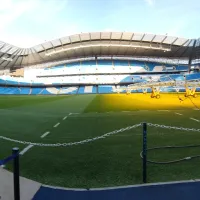All pitch sizes in soccer are not equal. In fact, there is not a universally agreed upon set pitch size that all stadiums use. There are limits on the length, width, and size that the field can be. The two bylines of a soccer field must be equal on both sides and between 49 and 98 yards. The sidelines (i.e. touchlines) have to be equal on both sides and between 98 to 131 yards. Since there can be a difference in sizes from stadium to stadium, let’s take a closer look at how the differences impact soccer-playing styles.
National teams’ stadiums have stricter guidelines, with a range of width between 70 and 80 yards and a range of length between 110 and 120 yards. FIFA recommends a width of 74 yards and a length of 115 yards.
Why some teams prefer a longer pitch size
There’s a story surrounding Pep Guardiola when he first visited the Ethiad Stadium in 2016. He called in Manchester City’s grounds crew and negotiated a deal that the grounds crew would keep the grass shorter than 23 millimeters due to the quick passing, tiki-taka style he planned to employ at City.
While he did not change the Etihad Stadium’s pitch size, he likely changed his tactics to make use of the stadium’s 8,510 square yard size. It’s easier to pass and dribble on longer and wider pitches, meaning Guardiola’s tactics would be right at home (as it was at the Allianz Arena and Camp Nou).
Teams that prize natural fitness and cardio might also favor a longer field. Teams like Atletico Madrid, run by the ruthless fitness coach Oscar Ortega, have fields 105 yards long and 68 yards wide. That’s 8,664 square yards, with only five teams in LaLiga using more space than Atletico Madrid.
Although a lot of the pitch size may have to do with the funds in Atleti’s hands, Atletico Madrid’s passionate fans, their new possession strategies that help gas opposing strikers trying to press, their might and strength on the flanks, and their natural fitness make the Wanda Metropolitano both a hostile environment that teams fear playing, but also a field that drains opponents physically.
It’s not odd to see a lot of top teams have bigger fields thanks to a mix of money, playstyles, and regulations from FIFA.
Why some teams prefer short fields
Defensive-oriented teams will prefer shorter fields, as there is less space to cover, and they will not need to work as hard to win the ball. As the field widens or lengthens, teams begin to find time and space, and the game becomes faster. However, defensive teams will want to bog down the game in hopes of securing a draw or limiting the creativity and explosiveness of the attacking team.
Luton Town’s Kenilworth Road measures 110 by 72 yards, smaller than many Championship sides. Although the club is working on renovations to the stadium, boasting a capacity of 10,356, the club used it to its advantage as they rolled through last year’s EFL Championship with one of the league’s best defenses. Luton Town’s space-denying, clogged-up, low block only benefited from its small stadium.
Does it matter that much?
Although the ways that pitch size influences the beautiful game; through tactics, natural fitness, defense, and more, it’s only a tiny variable when looking at the grand scope of the game. The material and air resistance of the ball, the height of the grass and how healthy it is, the weather, and even the fans arguably have a greater impact on the game than field size. Usually, if a manager attributes field size as an excuse for his team’s loss, pundits and fans alike make fun of the manager.
That’s not to say that field size doesn’t affect the game right now. Managers have often reduced the size of the pitch to prevent teams from playing wide, free-flowing football.
Wales‘ Mark Hughes shaved some yards off the touchline to counter the explosive Brazilian wingers in May 2000. But, it didn’t work as Brazil‘s Rivaldo and Zé Roberto ran rampant for a 3-0 win.
Stoke City coach Tony Pulis would do the same thing, pushing their pitch size — especially against Arsenal — to the absolute minimum. It not only favored their defensive block but also helped their long-throw wizard Rory Delap make a bigger impact.
We shouldn’t get lost in the details of how a few yards can favor someone. However, the size of the soccer field certainly matters a lot.
Check out our handy guide on how to watch EFL Championship in USA if you want to keep up with all the exciting matches of this season.
PHOTO: IMAGO & PA Images














